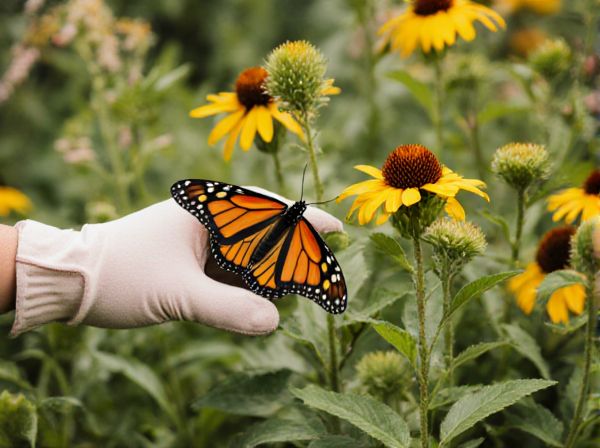
Pollinator-friendly Plants vs Ornamental Plants Illustration
Pollinator-friendly plants provide essential nectar and pollen resources that support the health and biodiversity of bees, butterflies, and other pollinators, while ornamental plants often prioritize aesthetic appeal over ecological function. Choosing pollinator-friendly species helps sustain local ecosystems by enhancing food availability and habitat quality for pollinators. Ornamental plants may contribute little to pollinator diets and can sometimes disrupt natural foraging patterns.
Table of Comparison
| Criteria | Pollinator-friendly Plants | Ornamental Plants |
|---|---|---|
| Purpose | Support pollinators like bees, butterflies, hummingbirds | Primarily aesthetic appeal and landscaping |
| Flower Characteristics | Rich in nectar and pollen, open shapes | Varied shapes, often hybridized for color and size |
| Ecological Impact | Enhances biodiversity, promotes ecosystem health | May require pesticides, limited benefits to wildlife |
| Examples | Milkweed, Lavender, Coneflower, Bee Balm | Roses, Petunias, Azaleas, Tulips |
| Maintenance | Usually low to moderate; adapted to local climate | Varies; often higher due to hybrid requirements |
| Growth Habit | Native or adapted species, promotes local flora | Often non-native, selected for visual traits |
Understanding Pollinator-Friendly Plants
Pollinator-friendly plants provide essential nectar and pollen resources that support the survival and reproduction of bees, butterflies, and other pollinators, unlike many ornamental plants that prioritize aesthetics over ecological function. Native species often have co-evolved relationships with local pollinators, making them more effective at sustaining healthy pollinator populations. Selecting diverse, region-specific pollinator-friendly plants enhances biodiversity and ensures continuous flowering periods critical for pollinator health.
Characteristics of Ornamental Plants
Ornamental plants are primarily cultivated for aesthetic appeal, featuring vibrant colors, intricate shapes, and diverse textures that enhance landscape design but often lack nectar and pollen necessary for pollinators. Many ornamental varieties have been selectively bred for traits like larger blossoms or prolonged blooming periods, which can reduce their attractiveness or accessibility to bees, butterflies, and other pollinating insects. These plants may also contain chemical treatments or hybrid genetics that do not support local pollinator species, contrasting with pollinator-friendly plants designed specifically to provide nourishment and habitat.
Ecological Benefits of Pollinator-Friendly Gardens
Pollinator-friendly plants such as milkweed, coneflowers, and bee balm provide essential nectar and pollen resources that support bees, butterflies, and other pollinators, ensuring biodiversity and ecosystem stability. Unlike ornamental plants, which often prioritize aesthetic appeal over ecological function, pollinator-friendly gardens enhance habitat connectivity and improve pollination services vital for food production and native plant reproduction. Incorporating native flowering species in gardens reduces dependency on chemical inputs, promoting healthier soil and water quality while sustaining local wildlife populations.
Visual Appeal: Ornamental vs. Pollinator-Friendly Choices
Ornamental plants prioritize visual appeal through vibrant colors and structured forms, enhancing garden aesthetics with curated beauty. Pollinator-friendly plants, though often equally colorful, emphasize nectar and pollen-rich blooms that attract bees, butterflies, and hummingbirds, supporting biodiversity. Choosing pollinator-friendly species like milkweed, coneflower, and lavender balances aesthetic charm with ecological benefits.
Top Pollinator-Friendly Plants for Your Garden
Top pollinator-friendly plants such as milkweed, coneflowers, and bee balm attract bees, butterflies, and hummingbirds, supporting essential pollination processes that enhance garden biodiversity. These plants provide nectar and pollen resources throughout the growing season, unlike many ornamental plants that often lack sufficient nutritional value for pollinators. Incorporating native pollinator-friendly species in your garden promotes ecosystem health, improves fruit and vegetable yields, and supports declining pollinator populations.
Common Ornamental Plants and Their Pollinator Value
Common ornamental plants such as petunias, impatiens, and marigolds often offer limited nectar and pollen resources, making them less beneficial for pollinators compared to native species. While visually appealing, many popular ornamentals lack the floral traits that attract bees, butterflies, and other pollinators, resulting in low ecological support. Selecting pollinator-friendly plants like coneflowers, milkweed, and lavender enhances biodiversity and promotes healthy pollinator populations in gardens and urban landscapes.
Impact on Local Biodiversity
Pollinator-friendly plants significantly enhance local biodiversity by providing essential nectar and pollen resources that support native bee, butterfly, and bird populations, fostering ecosystem resilience. In contrast, ornamental plants often prioritize aesthetics over ecological function, potentially offering limited or no benefits to pollinators and sometimes even inhibiting local species diversity through invasive tendencies. Prioritizing native pollinator-friendly species promotes habitat connectivity and sustains vital pollination services crucial for diverse plant communities and food webs.
Designing a Garden for Pollinators and Beauty
Incorporating pollinator-friendly plants such as milkweed, coneflowers, and bee balm enhances a garden's ecological value by attracting bees, butterflies, and hummingbirds while supporting biodiversity. Ornamental plants like roses and tulips offer vibrant colors and aesthetic appeal but often lack nectar and pollen resources essential for pollinators. Designing a garden that balances native pollinator-friendly species with visually appealing ornamentals creates a harmonious environment that promotes pollinator health and visually stunning landscapes.
Maintenance Differences: Ornamental vs. Pollinator-Friendly
Pollinator-friendly plants typically require less intensive maintenance than ornamental plants because they are adapted to local climates and soil conditions, reducing the need for frequent watering and fertilization. Ornamental plants often demand regular pruning, pest control, and nutrient supplementation to maintain their aesthetic appeal, increasing overall upkeep time and resources. Choosing pollinator-friendly species supports biodiversity while lowering garden maintenance efforts compared to traditional ornamental gardening.
Choosing the Right Plants for Your Garden’s Goals
Pollinator-friendly plants such as native wildflowers, milkweed, and lavender provide essential nectar and habitat for bees, butterflies, and other beneficial insects, supporting biodiversity and ecosystem health. Ornamental plants often prioritize aesthetic appeal but may lack the necessary pollen and nectar resources to sustain pollinators effectively. Selecting plants based on garden goals ensures that pollinator-friendly varieties enhance environmental benefits while ornamental choices fulfill visual design preferences.
Pollinator-friendly Plants vs Ornamental Plants Infographic

 gardendif.com
gardendif.com